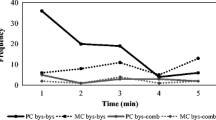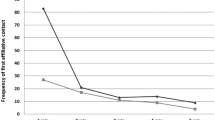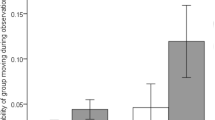Abstract
Reconciliation is the most extensively studied conflict resolution mechanism in animal societies. However, despite the extensive literature on this topic, behaviors considered to represent postconflict affiliation have not been consistent across studies of reconciliation. Critically, reconciliation is usually defined as postconflict contact affiliation, e.g., grooming, and the importance of including interopponent distance regulation is often neglected. Moreover, to date, no study has simultaneously investigated different behavioral forms of reconciliation. We tested in two groups of wild Barbary macaques (Macaca sylvanus) the relative importance of postconflict close proximity and grooming in the mediation of two important costs of aggression: damage to the opponent’s social relationship and elevated postconflict anxiety. We provide evidence that close-proximity approaches function to resolve conflicts: Close-proximity approaches reduced the victim’s postconflict anxiety and were predicted by the quality of the social relationship with the opponent. Moreover, postconflict grooming alone, although predicted by the quality of the opponent’s social relationship, did not influence the victim’s elevated postconflict anxiety. Our results suggest that interopponent distance regulation plays an important role in reconciling the costs of aggression in Barbary macaques. We advocate that further efforts should be made to test which behaviors play a role in conflict resolution in different species. This is important because even closely related species may differ in the function of behaviors that superficially appear to be rather similar. Moreover, the choice of behaviors used to study conflict resolution determines the frequency with which reconciliation is observed and can thus bias comparisons across species.




Similar content being viewed by others
References
Abegg, C., Thierry, B., & Kaumanns, W. (1996). Reconciliation in three groups of lion-tailed macaques. International Journal of Primatology, 17(5), 803–816.
Arnold, K., & Barton, R. (2001). Postconflict behavior of spectacled leaf monkeys (Trachypithecus obscurus). I. Reconciliation. International Journal of Primatology, 22, 243–266.
Aureli, F. (1997). Post-conflict anxiety in nonhuman primates: The mediating role of emotion in conflict resolution. Aggressive Behavior, 23(5), 315–328.
Aureli, F., & de Waal, F. B. M. (2000). Natural conflict resolution. Berkeley: University of California Press.
Aureli, F., van Schaik, C. P., & van Hooff, J. A. (1989). Functional aspects of reconciliation among captive long-tailed macaques (Macaca fascicularis). American Journal of Primatology, 19(1), 39–51.
Aureli, F., Veenema, H. C., van Panthaleon van Eck, C. J., & van Hooff, J. A. (1993). Reconciliation, consolation, and redirection in Japanese macaques (Macaca fuscata). Behaviour, 124, 1(2), 1–21.
Aureli, F., Das, M., Verleur, D., & van Hooff, J. A. (1994). Postconflict social interactions among Barbary macaques (Macaca sylvanus). International Journal of Primatology, 15, 471–485.
Aureli, F., Cords, M., & van Schaik, C. P. (2002). Conflict resolution following aggression in gregarious animals: A predictive framework. Animal Behaviour, 64(3), 325–343.
Balasubramaniam, K. N., Dittmar, K., Berman, C. M., Butovskaya, M., Cooper, M. A., Majolo, B., Ogawa, H., Schino, G., Thierry, B., & de Waal, F. B. M. (2012). Hierarchical steepness and phylogenetic models: phylogenetic signals in Macaca. Animal Behaviour, 83, 1207–1218.
Call, J. (1999). The effect of inter-opponent distance on the occurrence of reconciliation in stumptail (Macaca arctoides) and rhesus macaques (Macaca mulatta). Primates, 40(3), 515–523.
Call, J. (2000). Distance regulation in macaques: A form of implicit reconciliation? In F. Aureli & F. B. M. de Waal (Eds.), Natural conflict resolution (pp. 191–193). Berkeley: University of California Press.
Castles, D., Aureli, F., & de Waal, F. B. M. (1996). Variation in conciliatory tendency and relationship quality across groups of pigtail macaques. Animal Behaviour, 52, 389–403.
Cheney, D. L., Seyfarth, R. M., & Silk, J. B. (1995). The role of grunts in reconciling opponents and facilitating interactions among adult female baboons. Animal Behaviour, 50(1), 249–258.
Cools, A. K. A., van Hout, A. J. M., & Nelissen, M. H. J. (2008). Canine reconciliation and third-party-initiated postconflict affiliation: Do peacemaking social mechanisms in dogs rival those of higher primates? Ethology, 114(1), 53–63.
Cooper, M. A., Bernstein, I. S., & Hemelrijk, C. K. (2005). Reconciliation and relationship quality in Assamese macaques (Macaca assamensis). American Journal of Primatology, 65, 269–282.
Cooper, M. A., Aureli, F., & Singh, M. (2007). Sex differences in reconciliation and post-conflict anxiety in bonnet macaques. Ethology, 113(1), 26–38.
Cordoni, G., & Palagi, E. (2008). Reconciliation in Wolves (Canis lupus): New evidence for a comparative perspective. Ethology, 114, 298–308.
Cords, M. (1992). Post-conflict reunions and reconciliation in long-tailed macaques. Animal Behavior, 44, 57–61.
Cords, M. (1993). On operationally defining reconciliation. American Journal of Primatology, 29, 255–267.
de Waal, F. B. M. (1989). Peacemaking among primates. Cambridge, MA: Harvard University Press.
de Waal, F. B. M., & Ren, R. (1988). Comparison of the reconciliation behavior of stumptail and rhesus macaques. Ethology, 78, 129–142.
de Waal, F. B. M., & van Roosmalen, A. (1979). Reconciliation and consolation among chimpanzees. Behavioral Ecology and Sociobiology, 5(1), 55–66.
de Waal, F. B. M., & Yoshihara, D. (1983). Reconciliation and redirected affection in rhesus monkeys. Behaviour, 85, 224–241.
Fraser, O., & Aureli, F. (2008). Reconciliation, consolation and postconflict behavioral specificity in chimpanzees. American Journal of Primatology, 70, 1114–1123.
Fraser, O. N., & Bugnyar, T. (2011). Ravens reconcile after aggressive conflicts with valuable partners. PLoS One, 6(3), e18118.
Fraser, O. N., Schino, G., & Aureli, F. (2008). Components of relationship quality in chimpanzees. Ethology, 114(9), 834–843.
Hesler, N., & Fischer, J. (2008). Gestural communication in Barbary macaques (Macaca sylvanus): An overview. In J. Call & M. Tomasello (Eds.), The gestural communication of apes and monkeys (pp. 159–195). Mahwah, NJ: Lawrence Erlbaum Associates.
Kutsukake, N., & Castles, D. L. (2001). Reconciliation and variation in post-conflict stress in Japanese macaques (Macaca fuscata fuscata): Testing the integrated hypothesis. Animal Cognition, 4(3), 259–268.
Maestripieri, D., Schino, G., Aureli, F., & Troisi, A. (1992). A modest proposal: Displacement activities as an indicator of emotions in primates. Animal Behaviour, 44(5), 967–979.
Majolo, B., & Koyama, N. (2006). Seasonal effects on reconciliation in Macaca fuscata yakui. International Journal of Primatology, 27(5), 1383–1397.
Majolo, B., Ventura, R., & Koyama, N. F. (2009). A statistical modelling approach to the occurrence and timing of reconciliation in wild Japanese macaques. Ethology, 155(2), 152–166.
Majolo, B., Ventura, R., & Schino, G. (2010). Asymmetry and dimensions of relationship quality in the Japanese macaque (Macaca fuscata yakui). International Journal of Primatology, 31, 736–750.
McFarland, R., & Majolo, B. (2011a). Reconciliation and the costs of aggression in wild Barbary macaques (Macaca sylvanus): A test of the integrated hypothesis. Ethology, 117, 928–937.
McFarland, R., & Majolo, B. (2011b). Grooming coercion and the post-conflict trading of social services in wild Barbary macaques. PLoS One, 6, e26893.
McFarland, R., & Majolo, B. (2011c). Exploring the components, asymmetry and distribution of relationship quality in wild Barbary macaques (Macaca sylvanus). PLoS One, 6, e28826.
McFarland, R., & Majolo, B. (2012). The occurrence and benefits of postconflict bystander affiliation in wild Barbary macaques, Macaca sylvanus. Animal Behaviour, 84, 583–591.
Patzelt, A., Pirow, R., & Fischer, J. (2009). Post-conflict affiliation in Barbary macaques is influenced by conflict characteristics and relationship quality, but does not diminish short-term renewed aggression. Ethology, 115(7), 658–670.
Petit, O., Abegg, C., & Thierry, B. (1997). A comparative study of aggression and conciliation in three cercopithecine monkeys (Macaca fuscata, Macaca nigra, Papio papio). Behaviour, 134, 415–432.
Pinheiro, J. C., & Bates, D. M. (2000). Mixed effects models in sand S-PLUS (1st ed.). New York: Springer-Verlag.
Rowell, T. E., & Olson, D. K. (1983). Alternative mechanisms of social organization in monkeys. Behaviour, 86, 31–54.
Schaffner, C. M., & Caine, N. G. (2000). The peacefulness of cooperatively breeding primates. In F. Aureli & F. B. M. de Waal (Eds.), Natural conflict resolution (pp. 155–169). Berkeley: California University Press.
Schino, G. (2000). Beyond the primates: Expanding the reconciliation horizon. In F. Aureli & F. B. M. de Waal (Eds.), Natural conflict resolution (pp. 225–242). Berkeley: University of California Press.
Schino, G., Perretta, G., Taglioni, A. M., Monaco, V., & Troisi, A. (1996). Primate displacement activities as an ethopharmacological model of anxiety. Anxiety, 2, 186–191.
Silk, J. B., Cheney, D. L., & Seyfarth, R. M. (1996). The form and function of post-conflict interactions between female baboons. Animal Behaviour, 52(2), 259–268.
Silk, J. B., Alberts, S. C., & Altmann, J. (2003). Social bonds of female baboons enhance infant survival. Science, 302(5648), 1231–1234.
StataCorp. (2007). Stata Statistical Software: Release 10. College Station, TX: Stata Press.
Thierry, B. (2000). Covariation of conflict management patterns across macaque species. In F. Aureli & F. B. M. de Waal (Eds.), Natural conflict resolution (pp. 106–128). Berkeley: University of California Press.
van Schaik, C. P. (1989). The ecology of social relationships amongst female primates. In V. Standen (Ed.), Comparative socioecology: The behavioural ecology of humans and other mammals (pp. 195–218). Oxford: Blackwell.
Veenema, H. C., Das, M., & Aureli, F. (1994). Methodological improvements for the study of reconciliation. Behavioural Processes, 31(1), 29–37.
York, A. D., & Rowell, T. E. (1988). Reconciliation following aggression in patas monkeys, Erythrocebus patas. Animal Behaviour, 36(2), 502–509.
Acknowledgments
We thank Mohamed Qarro for his support in the field; the Commissariat aux Eaux et Forêts et à la Lutte Contre la Désertification of Morocco for research permission; and Chris Young, Laëtitia Maréchal, Pawel Fedurek, and Paolo Piedimonte for assistance in data collection. We thank Joanna Setchell and two anonymous reviewers for their useful comments on our manuscript.
Author information
Authors and Affiliations
Corresponding author
Rights and permissions
About this article
Cite this article
McFarland, R., Majolo, B. The Importance of Considering the Behavioral Form of Reconciliation in Studies of Conflict Resolution. Int J Primatol 34, 15–29 (2013). https://doi.org/10.1007/s10764-012-9643-y
Received:
Accepted:
Published:
Issue Date:
DOI: https://doi.org/10.1007/s10764-012-9643-y




